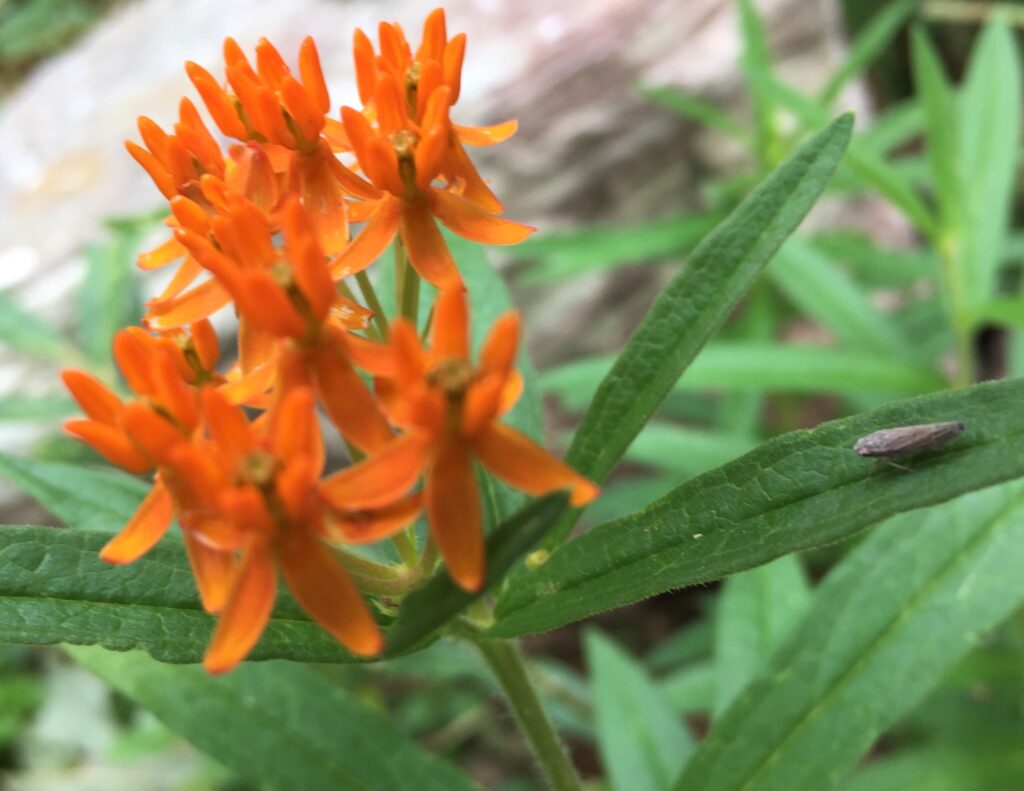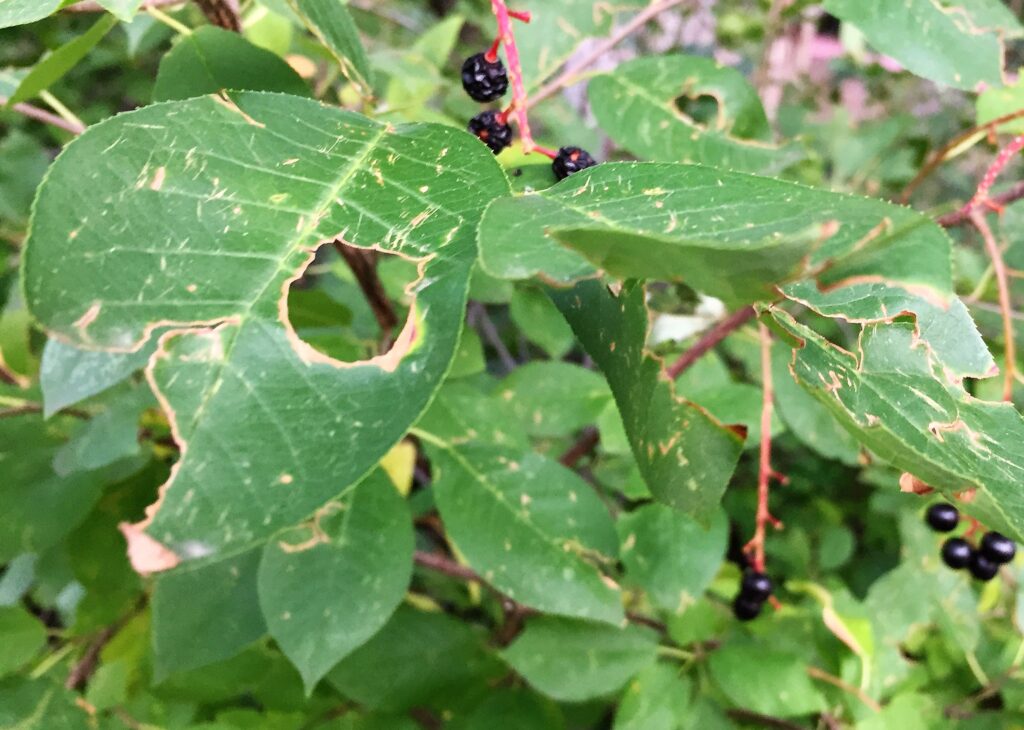By Deborah Lebow Aal
This is the time of year when gardeners put their feet up and happily look through catalogues, thinking about next year’s garden. Because let’s face it, every gardener’s best garden is next year. Next year, my plants will all be in the right place, just the way I want them…. It’s tempting when looking through these catalogues, to want the newest exotic plant, the newest variety of roses, the most beautiful blossoms you’ve ever seen. So, I thought it a good time to remind everyone why native plants are important. Sorry for those of you who have heard this so many times, but even my sister said, and I quote, “I know natives are important, I just can’t remember why.”

I know, if you’re reading this you have some idea of why planting native plants in your garden is important, but we all need a pep talk every now and again. Here’s the bottom line. If you are a property owner, you have an opportunity to use your little piece of land for more than just beauty. You have an opportunity to use your property to support wildlife and biodiversity, and it’s incredibly important to do so, now, more than ever. It’s your opportunity to be an environmental hero. Why?

Insects are a vital component to a healthy ecosystem. Native plants support more insect populations than non-natives (exotics), as they co-evolved. Insect populations support birds, and birds support … you get the food-web picture. But I want to make three points which should hammer home just how important it is today to plant natives in your yard.
What’s happening to insect populations and the bird populations?
It has been termed an “Insect Armageddon.” Entomologists are saying that as a result of many environmental impacts, the decline in insect populations is dramatic, and will have dire consequences. Environmental impacts include habitat changes, use of pesticides and global warming. And, it is safe to say that gardeners share some (maybe a small portion?) of the blame. We like our flowers to have minimal damage. Most gardeners I know avoid using pesticides or insecticides, until they have an invasion. They see aphids or Japanese beetles, en masse, and they panic. So, even we, who know better, have been known to try to rid our gardens of insects. We have to stop. We have to embrace insects. Insects are the base of the food chain, the base of life as we know it. They are vitally important to the food we eat, and to the natural world. As Edward O. Wilson* said, “If all humankind were to disappear, the world would regenerate back to the rich state of equilibrium that existed 10,000 years ago. If insects were to vanish, the environment would collapse in chaos.” And, insects are vanishing. Without insects, as I indicated above, bird populations are disrupted. Ornithologists already believe that the decline in insect populations is having a huge impact on the declining bird populations.
What can we do about it? Plant native plants, leave leaf litter, providing habitat for many in the insect world, and lay off the pesticides. Recognize that insects are half the show! Enjoy them.


What’s happening to wild lands?
Wild Lands are also in decline. Many of us think that the national parks, forests and wildlands will save us. Our little piece of property can’t begin to make a difference. We have all that land set aside for the purpose of preserving nature “out there.” Well, we need to revise those thoughts. We have piece-mealed our “natural areas” so much that they don’t begin to “preserve nature.”
If you’ve gotten this far, you are probably saying, well, I have such a small piece of property. How can it make a difference? Well, the Denver Post had a front page article entitled “Concrete Metropolis.”** The densification of Denver has resulted in 38.24 percent of Denver being impervious surface, meaning hard surfaces (buildings, sidewalks, driveways, roads; 48% if you exclude the green space around DIA) That’s up from 20% in the mid 1970s. That means that well over a third of the city has been covered over, blocking the natural processing of water, resulting in potential stormwater issues; also resulting in a big net loss for biodiversity, with fewer green spaces to do the myriad of amazing things green spaces do, and leaving the rest of the “natural terrain” to pick up the slack. We need to make sure the non-paved surfaces are actually “vestiges of the ecosystems that once made this land such a rich source of life for its indigenous peoples, and later, for European colonists and their descendants. That most of our ecosystems are no longer rich is beyond debate…”***
What can we do about it? Treat whatever piece of property you have dominion over as if it was the most important piece of the ecosystem puzzle. Plant native plants and lay off the pesticides.
What’s going on with climate change?

And then there’s climate change. I throw up my hands on this one. It’s too big for me or for any individual to do anything about. That is true. But collectively, can we make a dent? Well, yes and no. I mean, big agriculture and industry have to do the heavy lifting. And if I must say so here, we need environmental regulations to make sure there’s a level playing field, and that all businesses are held to account for their climate impact (so says a former EPA employee like myself). But, I have to believe that if we each decided to treat our little piece of property like it made a difference to climate change, then maybe yes, it could have an impact. That means lowering your carbon footprint by reducing or taking out your grass, which has a huge impact, and replacing it with natives. Natives, for the most part, will use less water than non-natives, and you won’t need that gas guzzling lawn mower and fertilizers and pesticides for your grass anymore. Plant more trees, as they are a carbon sink. “Just think how much of the carbon emissions in the United States we could offset (and money we could save) if we reversed our course and started to replace some of our 40 million acres of lawn with trees.**** There are so many facets to climate change that I won’t go into here, but suffice it to say, planting natives with locally-sourced plants and seeds, will lower your carbon footprint.
What can we do about it?
Minimize or take out your lawn completely, and plant locally-sourced native plants. Learn to minimize your water usage at the same time, as, at least in the Front Range area, water is expected to be scarcer than it already is, in the near future. In Denver, it is estimated that 55% of residential water goes to maintaining our landscapes, which are mostly thirsty lawns. Natives, in general, require much less water.
Phew. That’s a load of information, and I didn’t mention one plant. Sometimes it’s good to go back to the basics. All this to make one point – your little piece of greenery is important. Make the most of it, ecologically, and plant native plants! Happy February!
*Edward O Wilson is a biologist and naturalist, well known as the “father of biodiversity.” His biological specialty was the study of ants. He is a Professor Emeritus at Harvard.
** The Denver Post, January 13, 2019, front page article by Bruce Finley.
*** From “Bringing Nature Home” by Douglas W. Tallamy. P. 12
**** Also from Bringing Nature Home, p. 136. Note that 40 million acres is probably a low estimate of the amount of property in lawns, as it is several years old. Note also that some say trees only sequester carbon for a few hundred years, until they die. A few hundred years sounds pretty good to me!
Curious to learn more about transforming your garden into a habitat with Colorado native wildflowers, grasses, shrubs, and trees? Check out our native gardening toolkit, register for an upcoming event, subscribe to our newsletter, and/or become a member – if you’re not one already!
